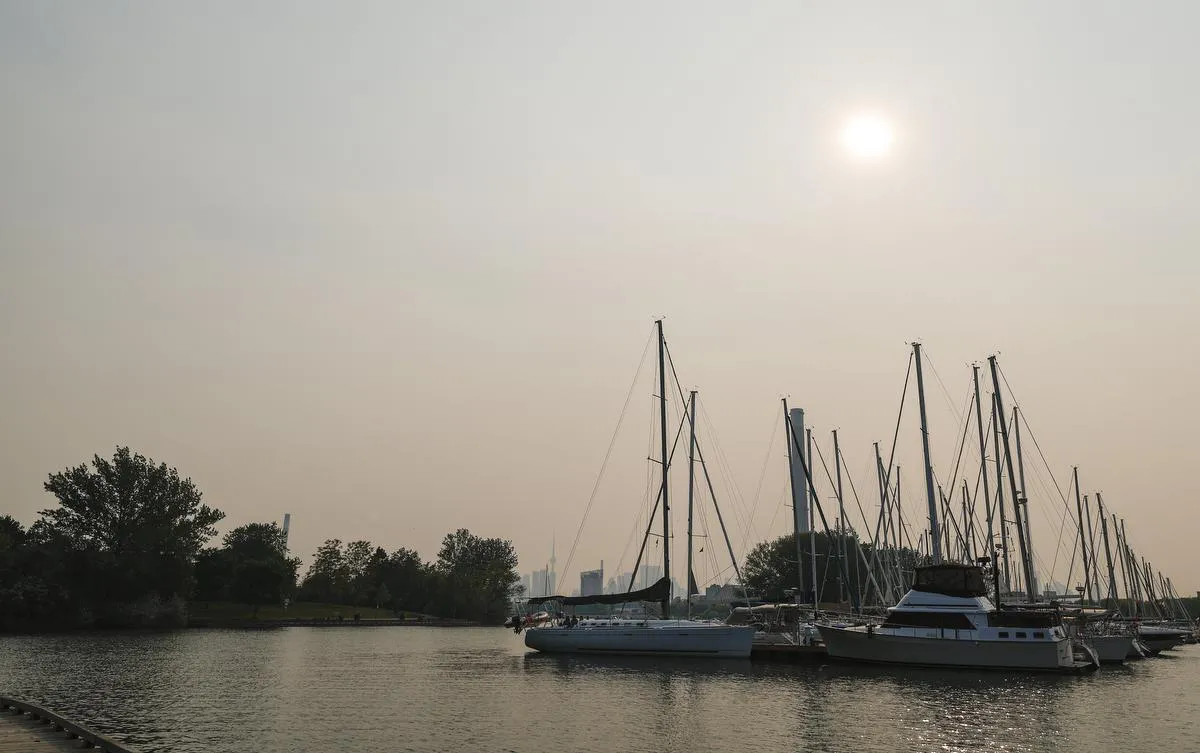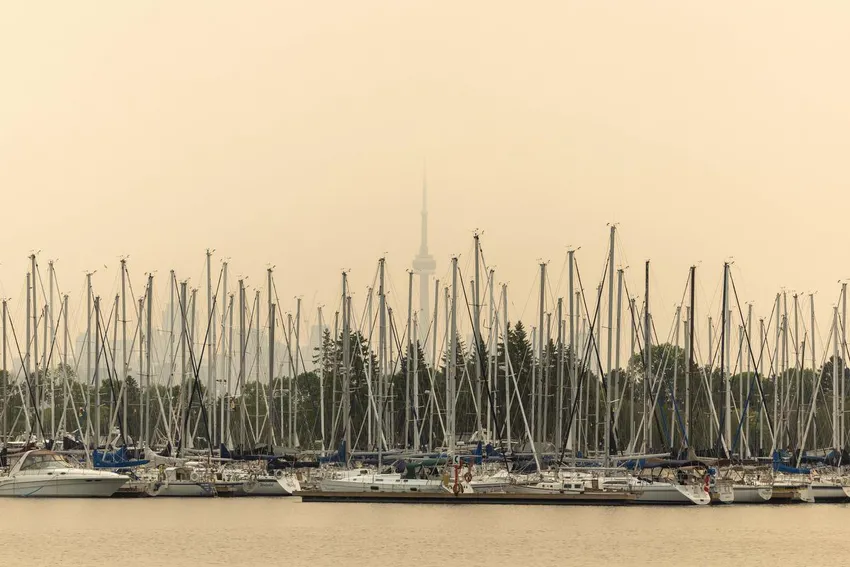This story is no longer updating. Please visit theStar.com for the latest on the wildfires burning in Quebec and northeastern Ontario.
4:45 p.m.: The Toronto District School Board says schools will be monitoring the Air Quality Health Index throughout the day Friday and will announce plans for recess in the morning.
“The past few days have shown us that it is incredibly difficult to predict air quality level in advance, as it is constantly changing throughout the day and varies from location to location within Toronto,” read an email sent to parents from the TDSB.
“Principals will check the AQHI throughout the school day and make a determination to either proceed with outdoor recess and activities (level 1-6 on the AQHI) or consider moving indoors (level 7-10), based on local conditions.”
3:46 p.m.: An orange haze from wildfire smoke has spread from Massachusetts to South Carolina and as far west as Missouri, threatening to disrupt flights and forcing millions to mask up or stay inside.
Inbound flights to New York’s LaGuardia Airport were grounded for a second day due to low visibility, while the Federal Aviation Administration warned that flights could also be halted at JFK, Newark and Teterboro.
How to protect your pets from wildfire smoke
3:40 p.m.: Smoke particles from wildfires can be particularly harsh on the elderly, children and those with breathing conditions — and pets aren’t immune, either.
For humans, protection looks like mask-wearing, closing doors and windows, and limited exposure to the smoke, according to the experts. So what do these conditions mean for pets who would usually go out for a much-needed walk, and how can pet owners protect them?
Read the full story here from Star reporters Manuela Vega and Santiago Arias-Orozco.
2:50 p.m.: As of 2 p.m., the air quality health index for Toronto is a level 5, indicating a “moderate risk” to health, according to Environment Canada. That value is expected to peak later today at a level 7, which poses a “high risk” to health.
How to create a cheap and easy air purifier at home
2:15 p.m.: Homemade air purifiers are making a comeback. These DIY devices, called Corsi-Rosenthal box purifiers, were popularized during the COVID-19 pandemic, when people sought to mitigate COVID-19 transmission in indoor settings. Now, however, as wildfire smoke envelops large swaths of southern Ontario and the U.S. eastern seaboard, the devices have been thrust in the spotlight once again.
Here’s how a DIY air purifier could improve your home’s air quality and protect you from wildfire smoke.
Read the full story from the Star’s Joshua Chong
1:46 p.m. U.S. President Joe Biden says he has ordered the U.S. federal government to respond promptly to any Canadian requests for more firefighters. He calls the fires “another stark reminder of the impacts of climate change.”
Should you wear a mask while the air quality is poor?
1:10 p.m. Smoke from wildfires raging in Quebec and northeastern Ontario is expected to blanket Toronto for much of the week, prompting a special air quality statement for the city and warnings of possible “high levels” of pollution.
With some Toronto residents already reporting the smell of smoke and conditions expected to worsen, experts say those in affected areas should consider wearing a mask and taking other precautions to reduce exposure.
“Every reduction in breathing this stuff provides a benefit to your health,” said Jeff Brook, an associate professor at the University of Toronto’s Dalla Lana School of Public Health and Department of Chemical Engineering and Applied Chemistry.
Read the full story from the Star’s Joshua Chong
12:58 p.m. The fireworks display in Niagara Falls is being cancelled for a second consecutive night.
“Due to the impact of the wildfires burning across the country, and the associated air quality advisories in many areas of Canada, including in Niagara, this evening’s Niagara Falls Fireworks program is being paused again this evening. Air quality conditions will be reviewed on a daily basis, with updated status reports issued at noon,” a statement read.
12:35 p.m. Operations at Toronto Pearson Airport are not currently impacted by air quality, Pearson airport tweeted, but some flights from the U.S. eastern seaboard could be affected. “If you’re flying today, check with your airline before heading to the airport,” Pearson said.
Toronto’s poor air quality
12:21 p.m. Canada’s most populous city is experiencing hazy skies and poor air quality as smoke from wildfires in Ontario and Quebec moves over Toronto.
Environment and Climate Change Canada has issued a special air quality statement for Toronto, warning of high levels of pollution and deteriorated air quality as a result of smoke from the fires.
The Toronto District School Board and the York Region District School Board have moved recess and other outdoor events indoors today, while the Toronto Catholic District School Board says its schools can consider indoor recess based on the air quality health index.
12:10 p.m. As of 11 a.m., the air quality health index for Toronto is a level 4, indicating a “moderate risk” to health, according to Environment Canada. That value is expected to peak this later today at a level 7, which poses a “high risk” to health.
11:40 a.m. Quebec’s wildfire fight is focused today in the province’s northern region where flames have reached the doorstep of a municipality of roughly 800 people.
Authorities say a wildfire is within 500 metres of Normétal, Que., located 720 kilometres northwest of Montreal.
Quebec’s forest fire prevention agency says it is confident the small community can be protected and that winds in the region are less strong than feared.
Read the full story from the Canadian Press
10:55 a.m. As an orange apocalyptic cloud of darkness and despair descended onto New York City Wednesday, Americans were understandably upset. And where did they point the finger of frustration?
To the north.
“EH!POCALYPSE NOW,” screamed a banner on the cover of the New York Post Thursday morning, playing homage to a joke from the 1999 South Park movie. “Canuck wildfires plunge NYC into eeire smoky hell. BLAME CANADA!”
Read the full story from the Star’s Justin Smirlies
10:20 a.m. Norwegian officials said the smoke from Canadian wildfires that has enveloped parts of the U.S. and Canada in a thick haze is expected to pour into Norway on Thursday.
Atmosphere and climate scientists with the Norwegian Climate and Environmental Research Institute used a forecast model to predict how the smoke would travel through the atmosphere.
9:57 a.m. As of 9 a.m. on Thursday, it’s currently 15 C in Toronto. Temperatures are expected to rise later in the day to 19 C with a 30 per cent chance of showers. Environment Canada is forecasting “widespread smoke” in the city for Friday, with a high of 20 C.
9:17 a.m. You can tell it’s arrived as soon as you open your eyes to find the summer light muted, occasionally with a slight haze. Maybe you cough for no reason. A dull throb sets up shop just behind your temples.
Summers in Western Canada mean long days of sunshine, drives to the mountains and camping trips under the endless Prairie sky. But in recent years, they have also come to mean stretches of smoke; thick clots of ash and tiny bits of debris thrown up by wildfires that block the light and fill the lungs.
It’s a significant health hazard, particularly for the elderly, children and those with breathing conditions, and a harbinger of a changing climate to come. The skies take on a vaguely postapocalyptic orange glow, street lights flicker to life at noon and each breath burns.
Read the full story from the Star’s Alex Boyd
9:10 a.m. If Canada were a colour, it would be orange.
The orange flames of the burning trees, from one end of this country to the other, pushing air quality levels in Toronto, across Ontario and elsewhere to their most hazardous levels.
The orange haze that this country’s wildfires have cast upon New York’s Empire State Building and other world-famous landmarks.
Read the full story from the Star’s Allan Woods
Inbound flights to New York’s LaGuardia airport grounded, Philadelphia region faces worst air quality
9 a.m. Inbound flights to New York’s LaGuardia airport were grounded again due to low visibility as the impact of Canadian wildfires continued Thursday.
The Philadelphia region faced the worst air quality in the U.S., while large swaths of the Northeast and Mid-Atlantic experienced unhealthy levels of pollution, according to the National Weather Service. Air conditions were set to deteriorate as far south as Alabama and Georgia. There’s a ground stop in effect for Philadelphia’s airport due to poor visibility.
8:50 a.m. The battle against hundreds of wildfires continues, as almost every jurisdiction in Canada remains under either heat or air quality warnings from the federal government.
The day after what was supposed to be national Clean Air Day, dozens of alerts remain in place for unseasonable heat or smoky air quality that kept millions of Canadians coughing and squinting. And forecasts suggest that air quality risks for the GTA, the Niagara region and southwestern Ontario will only increase through the end of the week.
How bad will the air quality be in Toronto?
As of 6 a.m. on Thursday, Environment Canada is forecasting the air quality health index for Toronto to reach a level 8 on Thursday, indicating a “high risk” to health. The federal department predicts air quality will enter into high-risk levels starting at noon. By comparison, the air quality health index peaked at a level 7 on Tuesday and Wednesday.
How long is the poor air quality expected to last?
In their most recent special air quality statement issued Thursday, Environment Canada and the Province of Ontario said poor air quality “may persist into the weekend.”
The federal government’s national wildfire smoke model, with projected forecasts for the next 72 hours, shows the GTA covered with smoke into Saturday morning.“It’s going to get worse before it gets better,” said David Phillips, a senior climatologist with Environment Canada, in an interview Tuesday. “So it is a long bout. It’s not just a one-day wonder.”
How many wildfires are there?
As of Thursday morning, there are 151 active fires burning in Quebec, according to the province’s fire prevention agency. In Ontario, the Ministry of Natural Resources and Forestry reported 56 active fires in the province.
Why is the air quality so poor in Toronto?
Despite being located hundreds of kilometres away from the major wildfires, Toronto has been significantly impacted by the resulting smoke and air pollution. That’s because winds have pushed the wildfire smoke from Quebec and northeastern Ontario to southern Ontario and the GTA.
Earlier in the week, Toronto saw northwesterly winds, bringing in smoke from fires burning in northern Ontario, explained Phillips.
But later in the week, “we’re going to see the winds shift more to the east and that’s a concern because it’s going to take the smoke from the Quebec fires, which are much more prevalent right now, and move it through Eastern Ontario, and down through the GTA,” he continued.
Toronto events cancelled over wildfire smoke
Toronto events cancelled over wildfire smoke
The Toronto Zoo is reducing its hours on Thursday, operating from 9:30 am to 3 pm. They encourage guests to reschedule their visits that day, and to wear a mask if unable. Live horse races at Woodbine Park and Woodbine Mohawk Park are also cancelled Thursday, in consideration of the “health and safety of the horses and racing participants,” Woodbine said in a statement.
The City of Toronto adjusted its programming around the smoke, including cancelling some of its city-run outdoor recreation programs scheduled for Wednesday and Thursday. Other programs were able to be moved indoors.
“Program registrants are being contacted directly and will be provided updates on any future cancellations or other changes,” Toronto said in a statement. City sport fields, baseball diamonds and parks will remain open.
Meanwhile, the city-operated Toronto Early Learning & Child Care Centres will be suspending outdoor activities; parents and guardians will receive direct updates as the situation progresses.
For people experiencing homelessness, Toronto is working to set up temporary contingency spaces at various shelters — like common rooms and other areas not used for sleeping — to accommodate more people inside. Toronto’s Streets to Homes community outreach team is performing wellness checks, offering water and encouraging people living outside to come indoors.
Toronto History Museums has also cancelled all outdoor programming until the Special Air Quality Statement lifts. St. Lawrence Market is currently reviewing its outdoor programming and will update its website should anything change.
How GTA school boards are reacting
School boards across the GTA have issued warnings over the smoke, with some limiting outdoor activity. These include the Toronto District School Board, which will be rescheduling or moving indoors all outdoor activities on Thursday. Included are “recess, athletic events, field trips and local school events.”
The Toronto Catholic District School Board recommended schools to “consider indoor recess” and to reschedule outdoor activities should students or staff have respiratory conditions. “We also reminded schools that using classroom HEPA Air Purifiers” helps reduce smoke particulates indoors, the board said.
The Peel District School Board encouraged students to “monitor how they are feeling for symptoms,” noting health impacts may be felt days after smoke exposure. While recesses are still outdoors, they recommend students avoid strenuous physical activity and will accommodate those who wish to stay inside when possible.
The Dufferin-Peel Catholic District School Board will be shortening the length of outdoor recesses on Wednesday and Thursday. Like other boards, they encourage students to avoid strenuous activity and said “schools will make every attempt to accommodate those who wish to stay inside or are experiencing symptoms such as coughing or throat irritation.”
The Durham District School Board has postponed or moved indoors all recess and outdoor activities as of Wednesday, and will be monitoring and providing daily updates on its website as the situation evolves.
The Durham Catholic District School Board also moved recess indoors as of Wednesday, with track and field moved inside for the day and its remaining events cancelled. “We anticipate similar recommendations will be in place on Thursday,” they said.
The Halton District School Board has cancelled all sports activities and will continue to monitor as the situation changes. The Halton Catholic District School Board did not issue an update as of Wednesday evening.
Will my flight be delayed due to the smoke?
New York City became the most polluted major city in the world on Wednesday, causing over 1,600 incoming flights to be delayed over poor visibility. But major airports in the GTA aren’t as worried.
A representative of Pearson Airport told the Star they’re experiencing no impact to operations on Wednesday and “are not anticipating an impact over the next 48 hours, when air quality is forecast to improve.” Toronto’s Billy Bishop Airport is also “not seeing any decrease in capacity” as of Wednesday, they told the Star.
WestJet and Porter Airlines told the Star they haven’t had or anticipate any delays due to smoke. Should this change, a spokesperson for WestJet said a notice will be posted to their website and impacted travellers will be notified over email.
Air Canada told the Star it’s “monitoring this situation closely,” and that some flights between Toronto and New York City on Wednesday were adjusted due to the latter’s poor visibility
How can you protect yourself from the wildfire smoke?
Experts say you can protect yourself by taking these precautions:
- Avoid strenuous outdoor activities
- Wear a mask — ideally an N95 mask — when outdoors
- Close all windows and doors in your house, if indoor temperatures are comfortable
- Install a High-Efficiency Particulate Air (HEPA) filter in your home
- Limit the use of kitchen and bathroom fans, which can create a negative air pressure system and draw more exterior air inside



